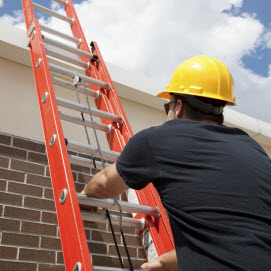March is National Ladder Safety Month, an opportunity to review your policies, training, and equipment. Whether you’re a small service business with a couple of step stools around for lightbulb changes or a large contractor that uses complex climbing equipment, you’ll want to read on for the latest on ladders.

According to OSHA, falls from portable ladders (step-, straight, combination, and extension) are one of the leading causes of occupational fatalities and injuries. Here’s a basic overview of what’s required for all ladders.
- Maintain ladders free of oil, grease, and other slip hazards.
- Do not load ladders beyond their maximum intended load or rated capacity.
- User ladders only for their designed purpose.
- Use ladders only on stable and level surfaces unless secured to prevent accidental movement.
- Do not use ladders on slippery surfaces unless secured or provided with slip-resistant feet.
- Secure ladders placed in areas such as doorways or passageways or where they can be displaced by workplace activities or traffic. Or, use a barricade to keep traffic or activity away from the ladder.
- Keep areas clear around the top and bottom of ladders.
- Do not move, shift, or extend ladders while they are in use.
- Use ladders equipped with nonconductive side rails if the worker or the ladder could contact exposed, energized electrical equipment.
- Face the ladder when moving up or down, and maintain three points of contact—for example, two hands and one foot or two feet and one hand—with the steps, rungs, and/or side rails of the ladder at all times.
- Use at least one hand to grasp the ladder when climbing.
- Do not carry objects or loads that could cause loss of balance and falling.
Additional OSHA requirements:
- Wooden ladders must not be coated with any opaque covering, except for identification or warning labels, which must be placed only on one face of a side rail.
- A competent person must inspect ladders for visual defects periodically and after any incident that could affect safety.
- Do not use single-rail ladders.
- Never use the top or top step of a stepladder as a step.
- Portable ladders with structural defects must immediately be marked as defective or tagged with “Do Not Use” or similar wording and taken out of service until they are repaired.
- Fixed ladders with structural defects must be taken out of service until they are repaired.
- The minimum clear distance between side rails for all portable ladders must be 11.5 inches.
- Rungs and steps of portable metal ladders must be corrugated, dimpled, coated, or treated to minimize slipping.
- If the total length of the climb on a fixed ladder is 24 ft or greater, the ladders must be equipped with ladder safety devices, self-retracting lifelines and rest platforms, or a cage or well with multiple ladder sections.
- Each step or rung of a fixed ladder must be able to support a load of at least 250 pounds.
Free Toolkit

Prevent injuries at your facility with our Ladder Safety Toolkit. Download this toolkit today and keep your workplace safety at the forefront of your facility by keeping your employees safe and reducing workplace injuries!
BLR’s Ladder Safety Toolkit. The kit includes:
- 5 Ladder Safety Toolbox Talks
- Ladder Safety Inspection Checklist
- Ladder Safety Poster
Use this handy toolkit to keep your employees safe, and avoid costly citations.
